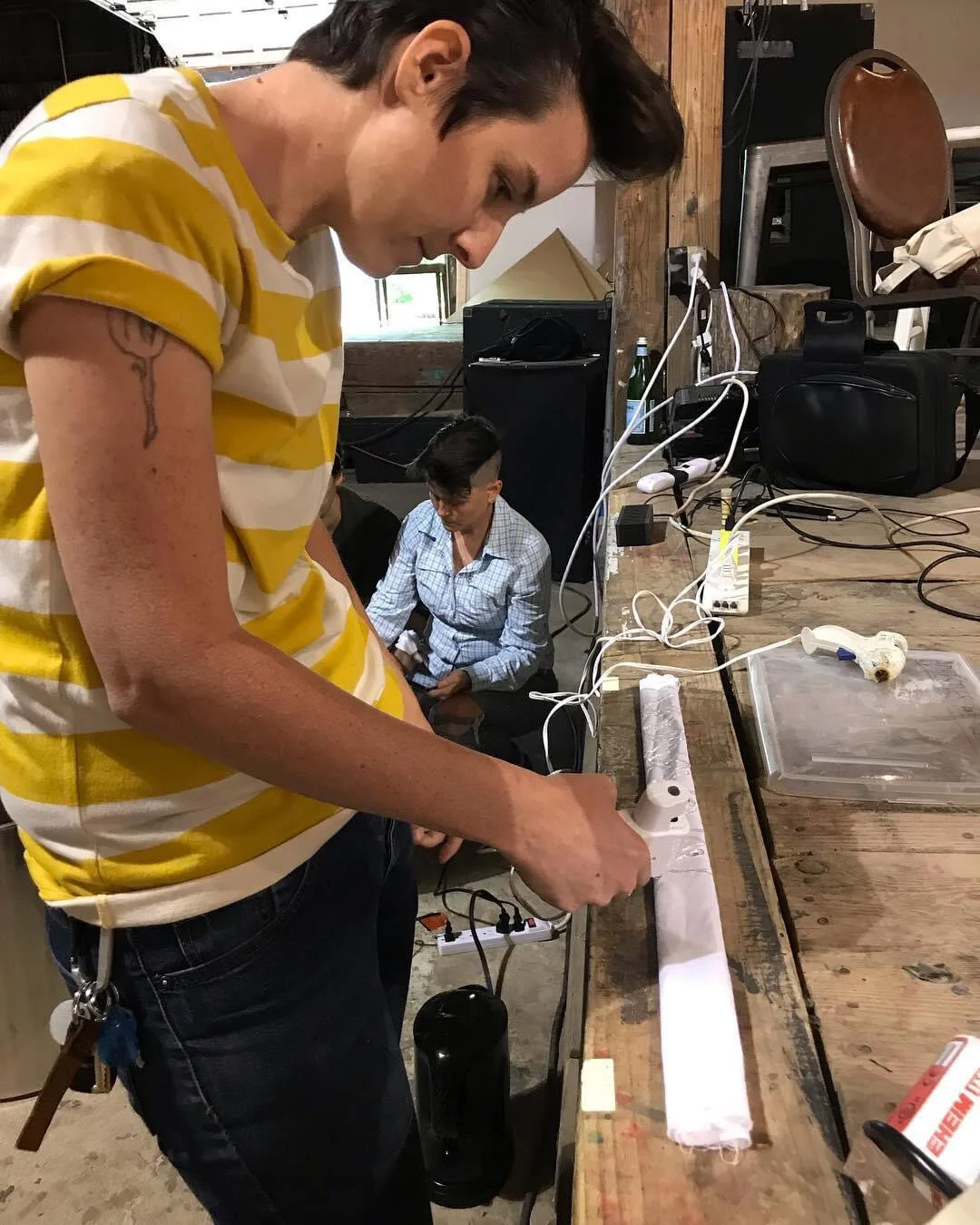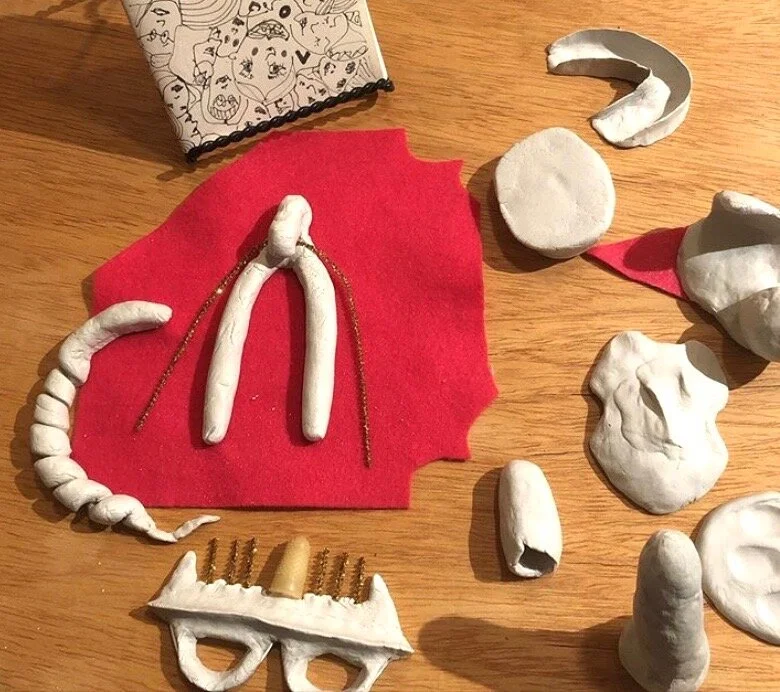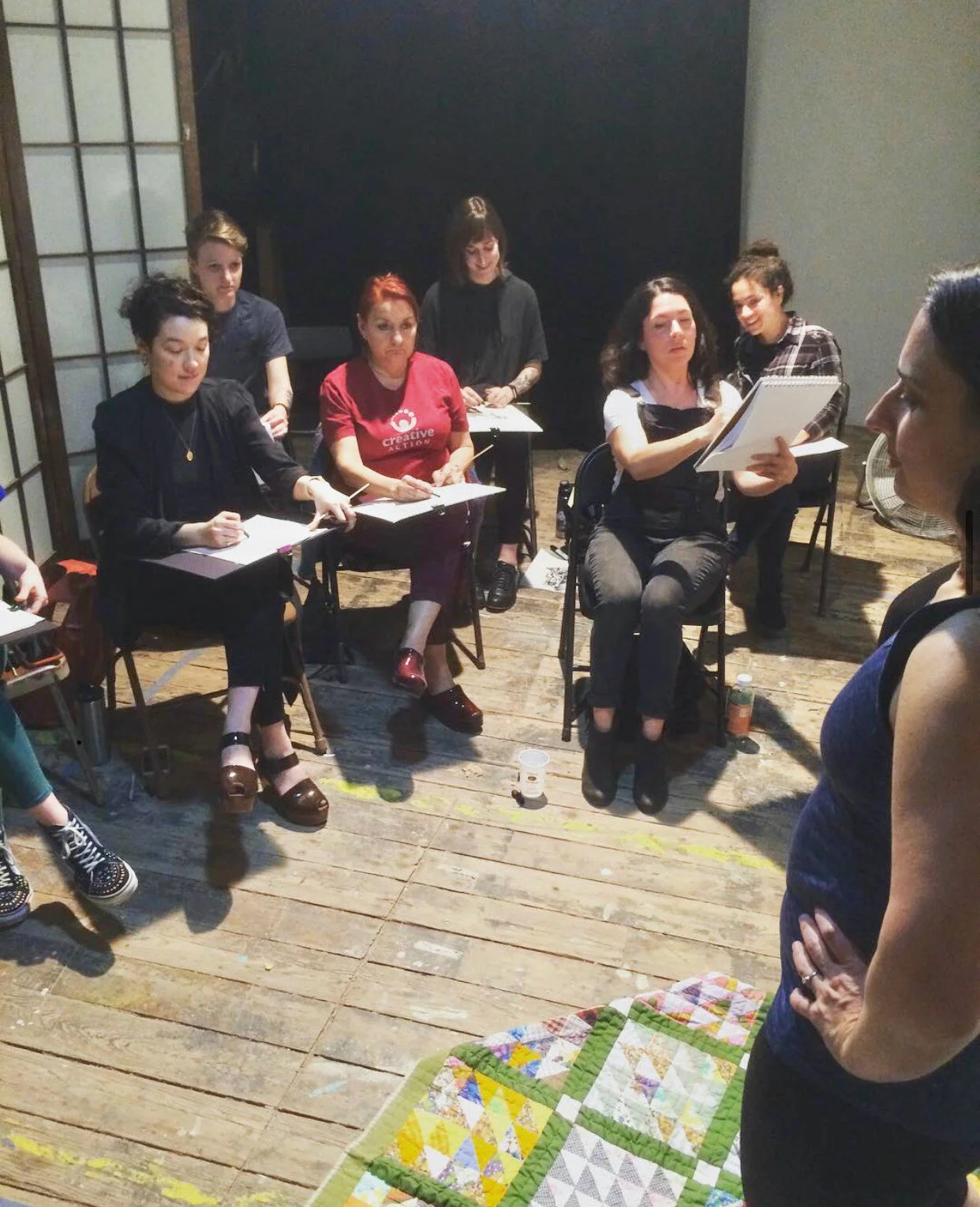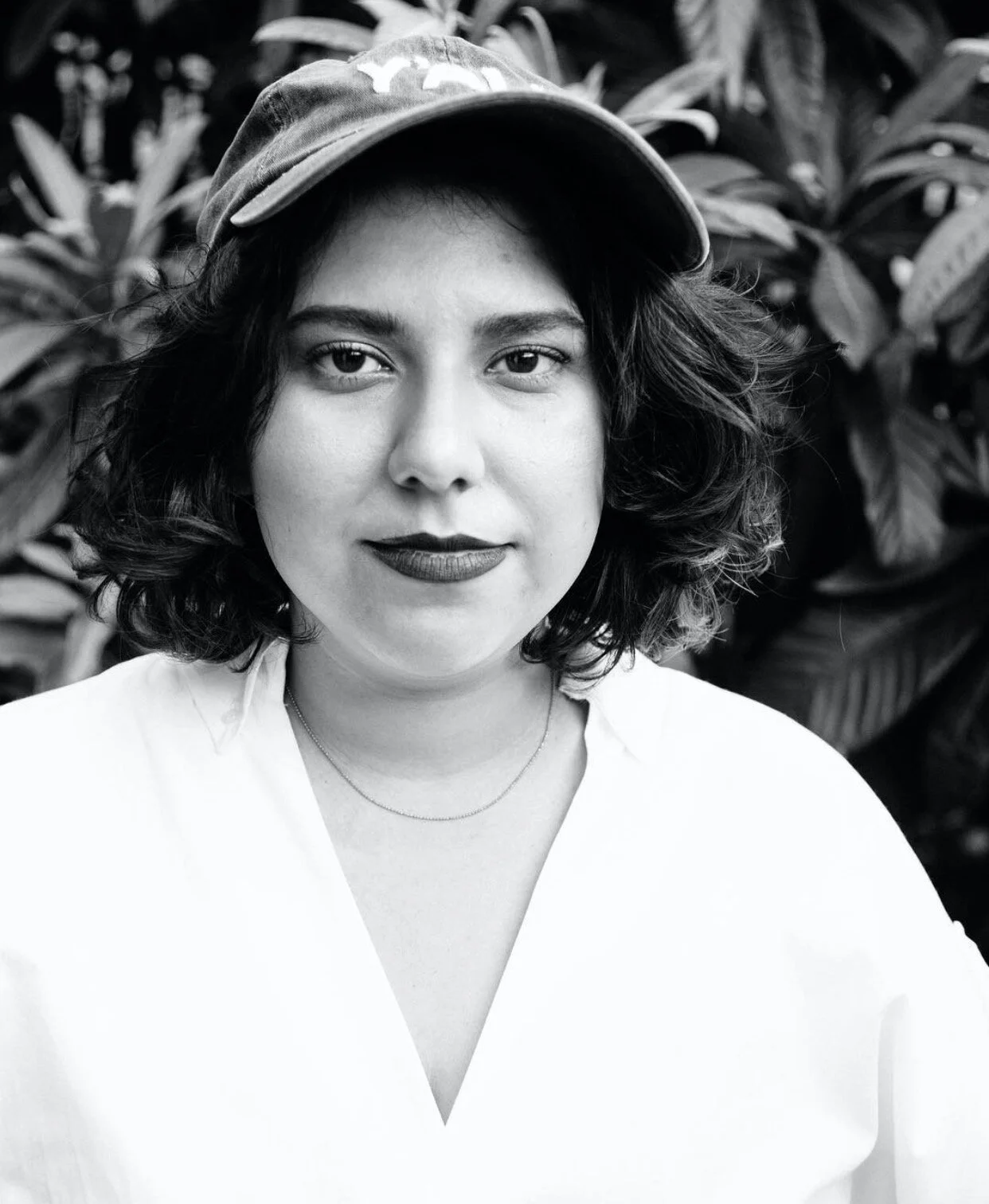Hive Arts Collective: Low-Stakes, Low-Cost, People-Meeting Opportunities
By Hayley Labrum Morrison
I managed to snag three out of four of the members of the Hive Arts Collective advisory panel for a video conference last week. Read on to see how you can get involved with one of Austin’s most inclusive art programs.
A Sketch of Hive Workshop Participants Moving Their Bodies, Courtesy of Concept Animals.
CA: Who is Hive Arts Collective and who is eligible to join?
IB: We have a non-linear organization style. No one has more power than another and we make all of our decisions as a collective. If you want to join, we have volunteer opportunities but really anyone can reach out and say “hey I have an idea for this thing, can we facilitate it together?”
AM: The four of us serve as an advisory panel and we do the day-to-day stuff and make all the decisions together. And that’s always going to evolve. The idea is that it’s a rotating group of people that can join the advisory panel to make decisions on Hive’s behalf and leave it whenever they want to. Even our facilitation structure beyond that is just “email if you have an interest and want to share it.” and then we’ll schedule you for a program. Or we do featured artist programs where we have residencies and shows. Anyone can join or not be part of it if they don’t want to. But once you’re in Hive Arts Collective, you’re kind of in it for life, tangentially.
Alex Morrison, (@alex.mwmorrison), (She/Her & They/Them), is a Collaborative Learning Consultant with a Mission to Work with Informal Austin Institutions to Make Innovative Programming that Focus on How We Interact. Alex is Behind the budgeting, Administration, and Grant Writing at Hive. Image Courtesy of Hive Arts Collective.
CA: Describe Hive Arts Collective for those that have never heard of it.
AM: Hive is a skill-sharing platform that is inclusively for women-identified and non-binary makers in Austin. We’re a collective of makers interested in swapping skills within the arts community. It could be music, performance, film, or hands-on DIY stuff. The idea is that we have a non-hierarchical structure where we offer accessible and affordable workshops for people to come and try something new. We believe that people should be able to try out a new skill without having to forfeit a chunk of their income. We are here for people to do things like figure drawing or cyanotype workshops for something like $7. When you take away the high price point you add a community structure that’s very valuable, and you get to know people better.
CA: What is Hive’s mission?
AM: Our mission is to foster an interest within different art forms and using that interest as a way to further connect ourselves to our community. And to encourage a type of collaboration with one another that’s open-ended and low stakes. It makes it so there is not much pressure and allows friendships to form.
Amanda Sparks (@stereo_ghost), (She/Her), is a Graphic Designer, Illustrator, and Student Studying UX at ACC. She Facilitates Workshops and is Designing Hive’s New Website. Image Courtesy of Hive Arts Collective.
CA: Why is it important to have a collective like Hive in Austin?
AS: It’s important to have a place to share skillsets, be a part of and build the community, and to meet people. And to have a space where you can go and create. We want it to be based on community, not price point.
IB: The barrier of entry is so low. We really try to program things with the cheapest way to get materials for our classes and skill-sharing events. We’ve seen collectives that charge something like $400 to build a bench, and we understand that, but the audience that we serve doesn’t have $400. At that higher price point, your participant demographics become less racially and socio-economically diverse.
AM: When we use a broad term like “community” it may be a disservice to the multiplicity of communities that exist within that term. Like, you can say “We offer hands-on maker-oriented workshops for the community,” but if you have a steep price tag it means that some people within that community have to pick and choose what they want. And just like Illyana was saying, we know those higher price points have reasons. Sometimes they pay people well and especially right now as we have to isolate ourselves and have a loss of income as artists, those fees are really great to help artists sustain themselves. But, they are not great for a community that has to choose between participating in a workshop or paying a bill. So instead of choosing one $70 workshop, you can pay $10 each for seven different workshops with Hive and become a well-rounded maker.
Neon Flux Workshop with Sarah Lim (@saralim) and OMG Squee (@squeeclub), 2019, Image Courtesy of Hive Arts Collective.
CA: Tell us about your featured artist program
AM: Hive started with people getting together as a community to watch movies in a backyard and talk about them. Beth Link (@b.linx) and Jenni Kaye (@_sensitivekind_) are a couple of the founding members. As Hive started to grow, they started to look for more spaces and more opportunities. It became less of an inward thing and more of an outward thing, which is “how can we support other people in their skill-building and skill-sharing." And that’s how the Featured Artist Program came about. It started through a Community Initiatives Program grant. Artists can submit their work for a residency with Hive that takes place over one month. They can make new works, show some old works, and they also do two hands-on workshops and have an exhibit in the Museum of Human of Achievement at the end of the residency. We pay them a stipend of $400 to do this. We have four artists total. We’re looking at how to create an opportunity for artists to round out their CV with a residency and exhibition, and then they also have to dive into teaching artistry and the art of educating and learning alongside people.
IB: It falls in line with our efforts to ensure a low barrier of entry. I have been accepted to residencies and then been told that I have to pay $1,200 to participate. It’s rare that artists get an opportunity to teach workshops and work on their own work in the process, and to show work during a busy time like open canopy in a space that’s visited by hundreds of people in one night. And then to have accolades afterward and move on and work in other spaces. It’s four of us helping, but we give all the support that the artists need to complete their work and teaching. A lot of artists don’t have the experience of taking what they know and synthesizing it for an audience to replicate. That portion of the program is such a valuable communication tool.
AM: Anyone can submit their portfolio along with abstracts for two workshops that they would do along with their CV. There is a very extreme grading rubric we use to make it as equitable as possible. One of the items within the rubric is the artist’s level of interest in facilitating educational experiences for others. As someone who is a collaborative learning consultant, this is all I do, so I’m a great resource to come in and help out with some facilitation techniques, and Illyana is amazing at videography so she can handle all of the documentation.
Alex Morrison at Work, Image Courtesy of Hive Arts Collective.
CA: Tell me about your usual workshop programming
IB: The four of us have interests in art and making things so coming from that place of “I want to make this, I want build this, I want to do this,” really informs us. We all connect on someone’s skill-sharing idea and then figure out who is going to facilitate it, how to source materials, and what the cost will be. It’s as practical as you can imagine. We program months in advance, so we had events programmed through the summer and booked artists and speakers for those events. We have used some of what Alex has learned at workshops from her visits to different places. One example is the sex toy workshop we did a couple of months ago. We knew we could do it and even make it more equitable and less gender-heavy.
AB: We offer a lot of hands-on activities like building a plant stand or woodworking or really getting into the nature of exploring an art method but we also do a lot of innovative programming that’s toward our mission of creating something that is just and equitable. Backing that up in programming is important. Like the pleasure workshop, it was from a workshop in London and they were having an amazing conversation about who has access to pleasure. Adrienne Maree Brown (@adriennemareebrown) was an amazing person to bring into that dialogue on pleasure activism but it wasn’t quite there. So when we looked at it we wanted to bring a lens of social justice into it. And that’s kind of the more innovative solution for creating something that has content but also is a hands-on making experience.
Pleasure Toys from Hive’s DI(F)Y Pleasure Workshop, 2019, Image Courtesy of Hive Arts Collective.
CA: Tell us about some of your most successful events
AM: Amanda has done some figure drawing workshops that have been amazing. Our most popular workshops have been things like printmaking, embroidery, or woodworking, things that are technical. When you are with your community you get to meet an artist on their own level as a human being. We’ve had incredible artists and builders like Jenn Steverson (@geneva_jean_) who are very knowledgeable about their own medium, so knowledgeable they can bring you to a new level to where you are having discussions of natural dyeing techniques and the history of indigo and really dive deep into the technique.
IB: Hive has done a lot of tactile workshops and we are working toward conceptual workshops. Something like experimental theater, or maybe you come but you don’t leave with something. Thinking about price points, if you can use your $5 to learn how to learn, that’s an entirely new skill that we haven’t seen a lot of workshops targeting.
AM: And the workshops with the higher price point can be amazing and result in an incredible looking piece of art that you built yourself. But, you are working with expensive materials. We are serving people that just want to figure out a way to connect with other people, try something out, or learn in a way that’s not so high-stakes, or maybe they just want a silly thing to do on a Thursday night. That’s where we come in.
AS: Our workshops feel a little bit more experimental and not as intense as an expensive class could be. Walking away with that experience is huge.
AM: And also if it goes wrong, that’s okay. We work from a failure-positive mindset. If you don’t walk away with something, or the thing didn’t work out like you wanted it to, we want to lean into the discussion of what your goals were and what happened and how it all worked out without someone leaving and thinking “I spent so much money on this and I’m not happy with it and it’s just going to sit in my house as a reminder of how unhappy I am."
Figure Drawing Workshop with Illustrator Marsha Riti (@marsha_personal), 2019, Image Courtesy of Hive Arts Collective.
CA: Are there any other ways for people to get involved?
IB: Because we are in this uncertain place right now, Amanda and I met earlier today about an entirely new rebrand and we will be presenting those explorations to the rest of the collective about how people can get involved. We’re pretty silent on Instagram right now. I feel that people just need to be safe and I don’t want to add to the noise of missed or upcoming opportunities. I feel that we should be present in our own circumstance and not worried about a workshop when some are trying to figure out where their rent is going to come from.
AM: If you have ever wanted to try something but you haven’t had access to it, like maybe you want to learn how to play drums, or screenprint, or dye fabric, or build a catapult, whatever, you can always shoot us an email and because we are a collective we can absolutely connect you to someone who is good at that thing.
Illyana Bocanegra (@hillbillyana), (They/Them), is a Graphic Designer for the Texas Senate and Has a Freelance Video Design Business. Illyana Facilitates Workshops and Designs Marketing Materials for Hive and Describes Themself as a Builder that Likes New Opportunities and Challenges. Image Courtesy of Hive Arts Collective.
CA: How is Hive adjusting to COVID-19?
IB: We are rebranding, creating a new website, an entirely new system of communication tools for people to utilize. I used to work for BossBabes (@bossbabesatx) and I am familiar with mass communication methods. This is a great time for us to quietly brainstorm new workshops and new ways to connect. We had these really amazing workshops planned for March and April that I’m really bummed about missing. We were going to pay homage to an experimental theater artist and Bridget and I have been working on it for the last few months. Unfortunately it didn’t happen, but that doesn’t mean we can’t do it in the future. I’m ready to get weird with randos again and come together to talk about stuff like pleasure or building stuff out of clay, and be part of the world again.
AM: I think what’s really nice about what we are doing right now, at least for me, is that we have just been checking in with each other and there hasn’t been any urgency to get things done. Personally, over the last couple of weeks, I have lost a lot of work and income and I’ve been scrambling to figure out what my next move is. Bridget, Illyana, and Amanda are there to check in with me on how I’m doing or collaborate on projects like a digital learning program I’m doing for Umlauf Sculpture Garden & Museum (@umlaufsculpture). Being able to just be there for each other is the best, it feels like The Baby-Sitters Club.
Bridget Brewer, (@bridgie.b), She/Her, is “a Queer Writer, Artist, and Performer” and is a Workshop Facilitator at Hive. Image Courtesy of Hive Arts Collective.
CA: Where do you ideally hope to see Hive in the next three years?
AM: The reason we all joined this is because we don’t see growth as a priority. Zac Traeger (@zactraeger) and the Museum of Human Achievement (@irl_moha) are incredible. Being able to stay at the Museum of Human Achievement for the next three years would be amazing.
IB: Hive is about low-stakes opportunities to learn and try new things. There are always things that we could be working on, but we like small, we don’t need to grow big big big. We aren’t coming from a place of capitalist values. If you asked other organizations this they might say “oh we need a bigger space, or we need this and we need that,” but I think we just want to find a way to sustain what we have been successful at, which is low-stakes, low-cost, people-meeting opportunities.
CA: How can fans follow along and get involved?
IB: I want to shoutout Alex right now, she is like our Hive mascot and everything Alex does feels like the true brand and nature of what Hive is. Alex just made an Instagram, y’all. Follow Alex, because on their stories they are doing daily household experiments and they are such a joy to watch. Follow anyone else from Hive. You can follow us on Facebook, Instagram, and our new website coming out soon. Instagram is the best method right now. Email or DM us.
AM: Yeah, become our friend!
Participants sculpting armatures in Miranda Cohen’s (@thecardboardlady) Papier Mache Workshop, 2019, Image Courtesy of Hive Arts Collective.
CA: Anything else you want to add?
IB: Vote! Vote them out of office!
AM: Think through ways to use productivity as mobilizing during quarantine. Don’t feel like you have to take this time as an artist or a maker to do something really productive or rebrand your whole system or come up with interesting ways to reach people. Just sit with yourself, take your time, get to know yourself, use this moment as a way to cultivate your own experiences.
IB: Oh one more thing on that! I read something that was like “oh did you know that in the Spanish flu era, so-and-so artist stayed home and created so-and-so masterpiece” and now I’m like “what am I doing?” but that is bullshit. It relates back to this capitalistic standard of worth, but we are not robots, and productivity doesn’t determine your worth. Chill and do some household experiments for no one but yourself.
AM: Yeah! Put a lightbulb in the microwave! Get in touch with your inner child and see where you go from there.
Follow Hive Arts Collective on Instagram at @hiveartscollective and stay tuned for the launch of their rebranded website at hivearts.org.











